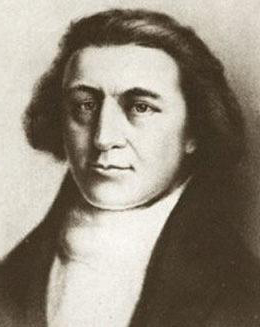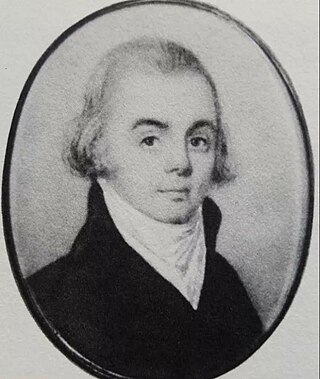
John Meares was an English navigator, explorer, and maritime fur trader, best known for his role in the Nootka Crisis, which brought Britain and Spain to the brink of war.

Robert Gray was an American merchant sea captain who is known for his achievements in connection with two trading voyages to the northern Pacific coast of North America, between 1790 and 1793, which pioneered the American maritime fur trade in that region. In the course of those voyages, Gray explored portions of that coast and in the year 1790 he completed the first American circumnavigation of the world. He was also noted for coming upon and naming the Columbia River, in 1792, while on his second voyage.

In May 1792, American merchant sea captain Robert Gray sailed into the Columbia River, becoming the first recorded American to navigate into it. The voyage, conducted on the privately owned Columbia Rediviva, was eventually used as a basis for the United States' claim on the Pacific Northwest, although its relevance to the claim was disputed by the British. As a result of the outcome the river was afterwards named after the ship. Gray spent nine days on the river trading fur pelts before sailing out of the river.

Adventure was built by the crew of Captain Robert Gray on his second voyage in the maritime fur trade to the Northwest Coast of North America. The 45-ton sloop was built to allow the trading venture to access smaller inlets the Columbia could not reach. At the end of his second voyage Gray sold the ship to the Spanish Navy. It was renamed Orcacitas and served the Naval Department of San Blas for some years.

Charles William Barkley was a ship captain and maritime fur trader. He was born in Hertford, England, son of Charles Barkley.
James Colnett was an officer of the British Royal Navy, an explorer, and a maritime fur trader. He served under James Cook during Cook's second voyage of exploration. Later he led two private trading expeditions that involved collecting sea otter pelts in the Pacific Northwest of North America and selling them in Canton, China, where the British East India Company maintained a trading post. Wintering in the recently discovered Hawaiian Islands was a key component of the new trade system. Colnett is remembered largely for his involvement in the Nootka Crisis of 1789—initially a dispute between British traders and the Spanish Navy over the use of Nootka Sound on Vancouver Island that became an international crisis that led Britain and Spain to the brink of war before being peacefully resolved through diplomacy and the signing of the Nootka Conventions.
Thomas Humphrey Metcalfe was an American maritime fur trader who worked with his father, Simon Metcalfe. After being separated from his father in a storm, Thomas sailed a small schooner with a crew of four from the vicinity of China to Nootka Sound on Vancouver Island where he was arrested by the Spanish. After being released he sailed to Hawaii, hoping to find his father. Instead, he was attacked and killed by Native Hawaiians in revenge for misdeeds committed by his father just days before.
Several vessels have been named African Queen:
Duke of Buccleugh, was launched at Yarmouth in 1783. In 1789 she became a slave ship in the triangular trade in enslaved people. She made five complete enslaving voyages. On her fifth she had to repel an attack by a French privateer in a single ship action. A French privateer captured her in September 1797 after she had delivered her captives on her sixth voyage.

John Boit Jr. was one of the first Americans involved in the maritime fur trade. He sailed as fifth mate under Captain Robert Gray on the second voyage of the Columbia Rediviva, 1790–1793. During the voyage he wrote a short but important journal in which he described the first time the Columbia River was located by Europeans or European Americans. From 1794–1796 he captained the Union on another maritime fur trading circumnavigation voyage from New England to the Pacific Northwest and China. Later he captained other vessels including the George and the slave ship Mac.
Hope was an American brigantine built at Kittery, Maine in 1789 for use in the maritime fur trade and owned by Thomas Handasyd Perkins, Russell Sturgis, and James Magee.
James Magee (1750–1801) was one of the first Americans involved in the Old China Trade and the Maritime Fur Trade. He was born in County Down, Ireland, probably near Downpatrick. James and his brother Bernard immigrated to New England shortly before the American Revolutionary War Described as a "convivial, noble–hearted Irishman", he married Margaret Elliot, sister of Thomas Handasyd Perkins, in October 1783. Magee lived in Roxbury, today part of Boston, ultimately in the Shirley–Eustis House, which he bought in 1798. His brother, Bernard Magee, was also a sea captain in the maritime fur trade.
Margaret was an American ship built at Boston and launched in the fall of 1791. It was built for use in the maritime fur trade and was owned by Thomas Handasyd Perkins, Russell Sturgis, James and Thomas Lamb, and James Magee. It was armed with eight cannon and six to eight swivel guns. On its maiden voyage it left Boston with a crew of 25.
HMS Garland was a frigate of the British Royal Navy, launched at Sheerness in 1748. She had an apparently uneventful career in the Royal Navy, not being listed as participating in engagements or battles. She did capture some French and American merchant vessels. Her most important capture in 1782, was that of the privateer Fair American, which had in some two years captured over 40 British vessels. The Navy sold her in 1783 and she became a slave ship, making six full voyages in the triangular trade in enslaved people. She was wrecked as she started for home having delivered the captives from her seventh voyage.
Recovery was launched in 1781, possibly under another name. She first appeared in British sources in 1781. She made two voyages as a Bristol-based slave ship in the triangular trade in enslaved people. The first such voyage gave rise to a landmark court case. During the second such voyage she, together with five other slave ships, bombarded Calabar for more than three hours to force the local native traders to lower the prices they were charging for slaves. She then became a West Indiaman until the French Navy captured her in 1797.
Thomas was the ship Sally that James Jones acquired in 1785. Thomas made seven voyages from Bristol as a slave ship in the triangular trade in enslaved persons. On her fourth such voyage,Thomas and five other enslaving ships, bombarded Calabar for more than three hours to force the local native traders to lower the prices they were charging for captives. The French captured her in 1794 as she was on her way for her eighth voyage.
Ranger was launched in Liverpool in 1789. She made four complete voyages as a slave ship in the triangular trade in enslaved people. A French privateer captured her in 1796 in a single ship action during her fifth voyage transporting enslaved people. She was recaptured, but thereafter disappears from online records.
Young Hero was launched at Liverpool in 1785. She made six complete voyages as a slave ship in the triangular trade in enslaved people. On her first and second voyages she sailed under an asiento, that permitted her owners to bring and sell captives in Spanish territories. She was seized and condemned in 1794 after having landed the captives from her seventh voyage.
Chaser first appeared under that name in British records in 1786. She had been launched in 1771 at Philadelphia under another name, probably Lord North. Lord North became Cotton Planter, and then Planter, before she became Chaser. Between 1786 and 1790 Chaser made four voyages as a whaler in the British southern whale fishery. She then became a merchantman. In 1794 a privateer captured her but the Spanish recaptured her. She became a Liverpool-based Slave ship in the triangular trade in enslaved people. In 1796 she was condemned in West Africa on her first voyage in the triangular trade before she could embark any enslaved people.
Brothers was launched in the Thirteen Colonies in 1772, probably under another name. From 1785 she became a Bristol-based slave ship. She made six complete voyages in the triangular trade, in all embarking 1880 enslaved people. The French captured her in December 1794 as she was on the first leg of her seventh such voyage and before she had embarked any captives. The main source for this article provided detail on crew turnover and death rates for her first three voyages. The first voyage had a particularly heavy mortality rate among the crew. The main source also provided data for her fourth, fifth, and sixth voyages for mortality rates on the Middle Passage among the enslaved people that she was carrying.





